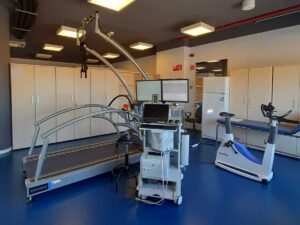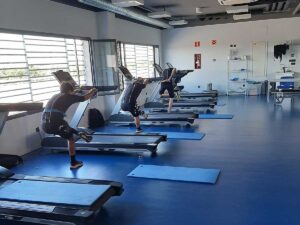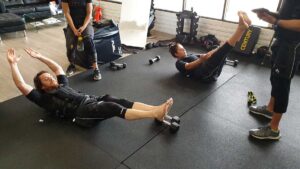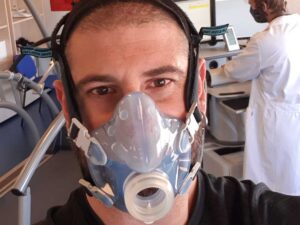Introduction:
For the past few years, Full Body Electrostimulation (WB-EMS) has found its place in strength training planning. Several studies in professional athletes of various types of sport have shown that complementary training with WB-EMS can achieve efficient results in terms of strength gains [2,3,4,5,6,7,8]. In a systematic review on EMS [9], we examined maximum strength training, high-speed strength, vertical jump height, and sprint time in trained and untrained athletes. The training period was from 3 to 6 weeks. The results showed an increase in the maximum isokinetic force in eccentric (37.1%) and in concentric (41.3%) and in the countermovement jump (CMJ) (19.2%), and the sprint time decreased (4.8% ).
Study description:
Thirty male hockey players aged 18 to 48 participated in this study. Most of these players started playing ice hockey as children, their training frequency varied from 2 workouts and one game per week to 3 workouts plus 1 or 2 games per week. Players were randomly and equally assigned to the two groups, Group A and Group B. Before training, Group A players weighed an average of 12.98 kg more, their thigh and upper arm circumferences were 4, and 2 cm larger respectively, as well as her waist. They also showed higher reference values in jump power, firing speed, and maximum strength, while those in group B achieved higher reference values in jump height and better sprint times.
In a randomized crossover design, one group was first trained with WB-EMS in addition to normal training for 12 weeks, followed by a phase without WB-EMS for 4 weeks. During the first six weeks, WB-EMS training was done in static mode, followed by another 6 weeks of dynamic training. The second group did it in exactly the same way. The WB-EMS period consisted of a total of 12 sessions over 12 weeks, one session per week, lasting 20 minutes each. Training times were set at an appropriate distance from training and ice hockey games to create a sufficient recovery period.
The training time was divided into different sections in which specific exercises were carried out for the respective disciplines:
– Sprint: Abductor training, side steps and static, dynamic and plyometric strides.
– Shooting & stability: Torso rotation, Crunch, weightless bench press, various types of shooting.
– Jump capacity: Squat with different ranges of movement, horizontal jumps, squat jumps, box jumps and CMJ.
– Isokinetic force: Static and dynamic squat, explosive squat, high jumps.
For the electrostimulation protocol, a frequency of 85 Hz was used with a pulse width of 350 µs. A 50% duty cycle was applied with a contraction time of 4 s. At the beginning of each session, the maximum intensity of individual tolerated pain was adjusted and a consecutive increase was sought throughout the training period.
The Test period was carried out at the beginning of the training, at 6 weeks of training and at 12 weeks. Results after the WB-EMS pause phase were tested 16 weeks after the start of training as a follow-up measure.
When analyzing the results, after the training with WB-EMS, the jumping power increased significantly in both groups. Regarding the vertical jump height, it also improved significantly in both groups. Sprint time improved significantly in group A, however, in group B there were no significant changes. On the other hand, maximum strength was also increased in both groups. Finally, there was no change in firing speed.
Conclusion:
Analyzing the above, we can affirm that training with WB-EMS is effective to improve physical performance in parameters of strength and speed.
Bibliography:
- Schuhbeck, Elisabeth Birkenmaier, Christof Schulte-Göcking, Heike Pronnet, Andreas Jansson, Volkmar Wegener, Bernd. (2019). The Influence of WB-EMS-Training on the Performance of Ice Hockey Players of Different Competitive Status. Frontiers in Physiology, 10, 1-8.
- Malatesta, D., Cattaneo, F., Dugnani, S., and Maffiuletti, N. A. (2003). Effects of electromyostimulation training and volleyball practice on jumping ability. J. Strength Cond. Res. 17:573. doi: 10.1519/00124278-200308000- 00025.
- Maffiuletti, N. A., Cometti, G., Amiridis, I. G., Martin, A., Pousson, M., and Chatard, J. C. (2000). The effects of electromyostimulation training and basketball practice on muscle strength and jumping ability. Int. J. Sports Med. 21, 437–443. doi: 10.1055/s-2000-3837.
- Billot, M., Martin, A., Paizis, C., Cometti, C., and Babault, N. (2010). Effects of an electrostimulation training program on strength, jumping, and kicking capacities in soccer players. J. Strength Cond. Res. 24, 1407–1413. doi: 10.1519/ JSC.0b013e3181d43790.
- Filipovic, A., Grau, M., Kleinöder, H., Zimmer, P., Hollmann, W., and Bloch, W. (2016). Effects of a whole-body electrostimulation program on strength, sprinting, jumping, and kicking capacity in elite soccer players. J. Sports Sci. Med. 15, 639–648.
- Pichon, F., Chatard, J.-C.,Martin, A., and Cometti, G. (1995). Electrical stimulation and swimming performance. Med. Sci. Sports Exerc. 27, 1671–1676.
- Babault, N., Cometti, G., Bernardin, M., Pousson, M., and Chatard, J.-C. (2007). Effects of electromyostimulation training on muscle strength and power of elite rugby players. J. Strength Cond. Res. 21, 431–437. doi: 10.1519/00124278- 200705000-00025.
- Maffiuletti, N. A., Bramanti, J., Jubeau, M., Bizzini, M., Deley, G., and Cometti, G. (2009). Feasibility and efficacy of progressive electrostimulation strength training for competitive tennis players. J. Strength Cond. Res. 23, 677–682. doi: 10.1519/JSC.0b013e318196b784.







